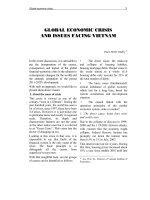SEGMENTATION, TARGETING, and POSITIONING
Bạn đang xem bản rút gọn của tài liệu. Xem và tải ngay bản đầy đủ của tài liệu tại đây (1.46 MB, 23 trang )
7. SEGMENTATION, TARGETING, and POSITIONING
Market Segmentation —
It is the separation of markets into distinctive
groups based on similar trait or traits toward
which a firm can direct its marketing efforts.
COLLEGE OF BUSINESS ADMINISTRATION
CHUNG-ANG UNIVERSITY
PROF HYUNSUK SUH
2
What is “STP”?
Segmentation, Targeting, and Positioning
SEGMENTATION - Dividing a market into number of distinct groups with distinct
needs, characteristics, or behavior who might require separate products or
marketing mixes.
TARGET - The process of evaluating each market segment’s attractiveness and
selecting one or more segments to enter.
POSITIONING - Arranging for a product to occupy a clear, distinctive, and desirable
place relative to competing products in the minds of target customers.
Kotler and Armstrong, 2008, 2010, 2013
3
Target Marketing Strategy consists of three separate steps. Marketers first divide the
market into segments based on customer characteristics, then select one or more
segments, and finally develop products to meet the needs of those specific segments.
Steps in Target Marketing Strategy
Solomon/Marshall/Stuart 2009
4
The objectives of the current chapter are described.
Objectives
To understand the process of market segmentation.
To understand how companies identify attractive market segments and
choose a target marketing strategy.
To understand how a company positions their products for competitive
advantage in the marketplace.
0. Objectives
5
The concept of market segmentation is illustrated below.
Concept of Market Segmentation
No Market Segmentation
Fully Segmented Market
Market Segmentation
By Gender: M, F
Market Segmentation
By Age Group: 1, 2, 3
Market Segmentation
By Gender and Age Group
2. Segmentation
6
The importance of market segmentation is illustrated below.
Importance of Market Segmentation
Market
segmentation
Market
segmentation
More precise
definition of
customers needs
and wants
More precise
definition of
customers needs
and wants
More accurate
marketing
objectives
More accurate
marketing
objectives
Improved resource
allocation
Improved resource
allocation
Better marketing
results
Better marketing
results
2. Segmentation
Any
Drawbacks?
7
A number of variables that can be used to segment customer markets is shown below.
Ways to Segment Consumer Markets
Example
2. Segmentation
demographic.exe+
+be havioral +geographi c.e xe
8
The Family Life Cycle (FLC) is a series of stages determined by a combination of age,
marital status, and the presence or absence of children.
Age
Age
Marital
Marital
Status
Status
Children
Children
Family Life Cycle (FLC)
2. Segmentation
Example
9
The market segments can be presented in several ways. Suppose the ice cream buyers
are asked how much they value sweetness and creaminess as two product attributes.
Three(3) different patterns can emerge
Patterns of Market Segmentation
HOMOGENEOUS PREFERENCES
Where all customers have roughly the same preferences.
The market shows no natural segment.
DIFFUSED PREFERENCES
Customer preferences may be scattered throughout the
space, indicating that customers vary greatly in their
preferences.
CLUSTERED PREFERNCES
The market might reveal distinct preference clusters,
called natural market segements.
Sweetnes
s
Creamines
Sweetnes
s
Creamines
Sweetnes
s
Creamines
Emerging Patterns
2. Segmentation
10
Not all segmentation is useful. For example, table salt buyers could be divided into
blond and brunette customers, but hair color is not relevant to the purchase of salt.
2. Segmentation
Measurable
Accessible
Differentiable
or
Responsiveness
Substantial
Factors
Affecting
Market
Segmentation
The size, purchasing power and profiles of
segments can be measured
e.g. Left-handed population
The market segments can be effectively
reached and served
e.g. Fragrance user who socialize a lot
The market segments are large or profitable
enough to serve, largest possible
homogeneous group
e.g. car for shorter than 4ft.
The segments are conceptually
distinguishable and respond differently to
different marketing mix element
e.g. Married-unmarried respond same to
particular perfume?
Effective Segmentation
11
Which segmentation variable does Mac-Gray MicroFrdge using?
Mac-Gray MicroFridge
Example
Mac-Gray
MicroFridge
What special benefit does
a MicroFridge offer, and to
which market segment
might this appeal?
2. Segmentation
12
Which segmentation variable does Coffee Joulies using?
Joulies: Thermodynamic ‘stones’ help keep coffee at the right temperature
Example
2. Segmentation
13
Company
marketing
mix
Market
Company
marketing
mix
SEG 1
SEG 2
SEG 3
CMM 1
CMM 2
CMM 3
SEG 1
SEG 2
SEG 3
Undifferentiated marketing
Mass
Differentiated marketing
Segmented
Concentrated marketing
Niche
A group of people or organizations for which an organization designs, implements,
and maintains a marketing mix intended to meet the needs of that group, resulting in
mutually satisfying exchanges.
Targeting Strategy
A firm may decide to ignore market
segment differences and target the
whole market with one offer.
A firm may decide to target several
market segments and design separate
offers for each.
It is especially appealing when company
resources are limited. Instead of going
after a small share of large market, a firm
goes after a large share of one or few
segments or niches
3. Targeting
14
The examples of the different targeting strategies are illustrated below.
P1
P2
P3
M1 M2 M3
P1
P2
P3
M1 M2 M3
Single Segment
Concentration
Selective
Specialization
Product Specialization
P1
P2
P3
M1 M2 M3
P1
P2
P3
M1 M2 M3
Market Specialization
Full Market Coverage
M = Market
P = Product
M1 M2 M3
P1
P2
P3
e.g. Porsche, Rolex
e.g. microscope to college,
hospital, lab
e.g. microscope, chemicals, and
burner to college lab
Categories of Targeting Strategies
3. Targeting
Example
15
•
고객의 가치 ( 예 : 구매이력 , 매출 비중 등 ) 또는 수익성에 따
라
고객을 세분화하여 관리하는가 ?
프로그램 A
프로그램 B
프로그램 D
프로그램 C
DB
Premium
Young
Dormancy
Practical
Customer
Occasional
Customer
Frequent
Buyer
Customer Segmentation
Target 고
객
Campaign
Premium
Young
휴면
Practical
Customer
Frequent
Buyer
Campaign
Feedbac
k
정보
Segmentation 별 마케팅 프로그램 개발
Dynamic Close Loop
Occasional
Customer
•
세분화된 고객별로 차별화된 서비스를 제공하고 있는가 ?
•
고객 세분화의 기준이 전사 각 부문에서 동일하게 적용되고 업
무에 활용되고 있는가 ?
•
고객 세분화의 기준이 회사의 방침 , 시장의 변화 등에 맞추어
신속하게 수정 . 보완되고 있는가 ?
•
Data Warehousing
•
Data Mining
•
Campaign Management
•
Customer Interaction Center
Customer Segmentation
( 척도 : 1. 전혀 아니다 2. 아니다 3. 보통이다 4. 그렇다 5. 매우 그렇다 )
Customer Analysis
Managing customers according to the different segmentation groups. Each segments’
strategy may differ according to their valuation.
Evaluation Criteria
Relevant CRM Components
3. Targeting
Example
16
Positioning is the act of designing the company’s offering and image to occupy a
distinctive place in the mind of the target market. The end-result is customer-focused
“value proposition.”
Value Proposition
Company and
Product Target Customers Benefits Price Value Proposition
Perdue
(chicken)
Quality-conscious
consumers of
chicken
Tenderness 10% premium More tender golden
chicken at a
moderate premium
price
Volvo
(station
wagon)
Safety-conscious
“upscale” families
Durability and
safety
20% premium The safest, most
durable wagon in
which your family can
ride
Domino’s
(pizza)
Convenience-
minded pizza
lovers
Delivery speed
and good
quality
15% premium A good hot pizza,
delivered to your
door door within 30
minutes of ordering,
at a moderate price
Example
4. Positioning
17
Products can be positioned for different
product class:
e.g. Margarines position against butter (I
can’t believe it’s not butter), chicken
from beef
Products can be positioned against the
competitor:
e.g. Burger King vs. McDonalds, Avis vs.
Hertz – We are number 2 so we work
harder!
Products can be positioned for their
user/usage:
e.g. Product can be based on the usage
which they are used-Multi-purpose
cleaner, Arm and Hammer baking soda
An effort to position the product distinctively dominant on customers perception is
called positioning strategy and some of the examples are described below.
Positioning Strategy
Products can be positioned on the
benefits they offer:
price/quality/attributes
e.g. Toothpaste-Crest reduced cavities,
Arm and Hammer whitens teeth
P
4. Positioning
Example
18
The word positioning was popularized by two advertising executives, Al Ries and Jack
Trout. They see ‘positioning’ as a creative exercise done with an existing product.
Positioning According to Ries and Trout
Positioning starts with a product. A piece of merchandise, a service, a company, and
institution, or even a person. . . . But positioning is not what you do to a product.
Positioning is what you do to the mind of the prospect. That is, you position the product
in the mind of the prospect.
Four (4) Strategic Alternatives
1. To strengthen its own current position in the customer’s mind
2. Grab and unoccupied positions
3. Deposition or Reposition the competition in customer’s mind
4. Exclusive Club Strategy
4. Positioning
19
Two consultants, Michael Treacy and Fred Wiersema, proposed a positioning
framework called ‘value disciplines.’ Within its industry, a firm could aspire to be the
product leader, the operationally excellence, or the customer intimacy.
Positioning According to Treacy and Wiersema
Value Discipline is based on the notion that in every market there is a mix of three types
of customers
1. Some customers favor the firm that is advancing on the technological frontier
2. Other customers want highly reliable performance
3. Still others want high responsiveness in meeting their individual needs
McDonald excels at operational excellence, but could not afford to slow down its
service to prepare hamburgers differently for each customer. Nor could McDonald
lead in new products because each addition would disrupt the smooth functioning of
its normal operations.
4. Positioning
Example
20
4. Positioning
A starting point in defining a competitive frame of reference for positioning is to
determine “Category Membership” - the products with which a brand competes and
which function as close substitutes.
Category Membership
Rising Crust Pizza®
DiGiorno identified this niche market of
consumers that really wanted a high
quality, good tasting product that would
bridge the gap between frozen and
carryout/delivery pizza. They wanted more
convenience and better value and that is
what DiGiorno brought them
Example
21
Once the competitive frame of reference for positioning has been fixed by defining the
target market and nature of competition, marketers can define the appropriate points-
of-difference and points-of-parity.
Points-of-Difference
Points-of-difference (PODs)
Attributes or benefits consumers
strongly associate with a brand,
positively evaluate, and believe they
could not find to the same extent
with a competitive brand
Points-of-Parity
Points-of-parity (POPs)
Associations that are not necessarily
unique to the brand but may be
shared with other brands
4. Positioning
22
When T-Fal sells its pans around the world, it takes into account each market’s
unique characteristics. The advertisement show how Korean customers can use T-
Fal pan conveniently and stored in tight spaces.
a. What unique selling proposition is this ad promoting?
b. Which of the product differentiation variables is being communicated in the ad?
Why is this variable important to the target market?
c. State the value proposition suggested by the T-Fal ad.
Solve the following example.
Positioning Exercise
In Class Exercise
4. Positioning
23
The summary of basic marketing STP is described below.
Market Segmentation
A group of consumers
who respond in a similar
way to a given set of
efforts
Market Positioning
Occupy a clear and
distinctive place relative
to competing products
Market Targeting
The process of
evaluating market
segment’s attractiveness
to decide which one(s) to
enter
1. Define variables for segmentation
2. Develop profiles for each segment
3. Develop measures to evaluate
segments
4. Determine target segment
5. Define market position of chosen
targets
6. Develop marketing mix strategy
Summary of STP strategy
Define the total market
5. STP









